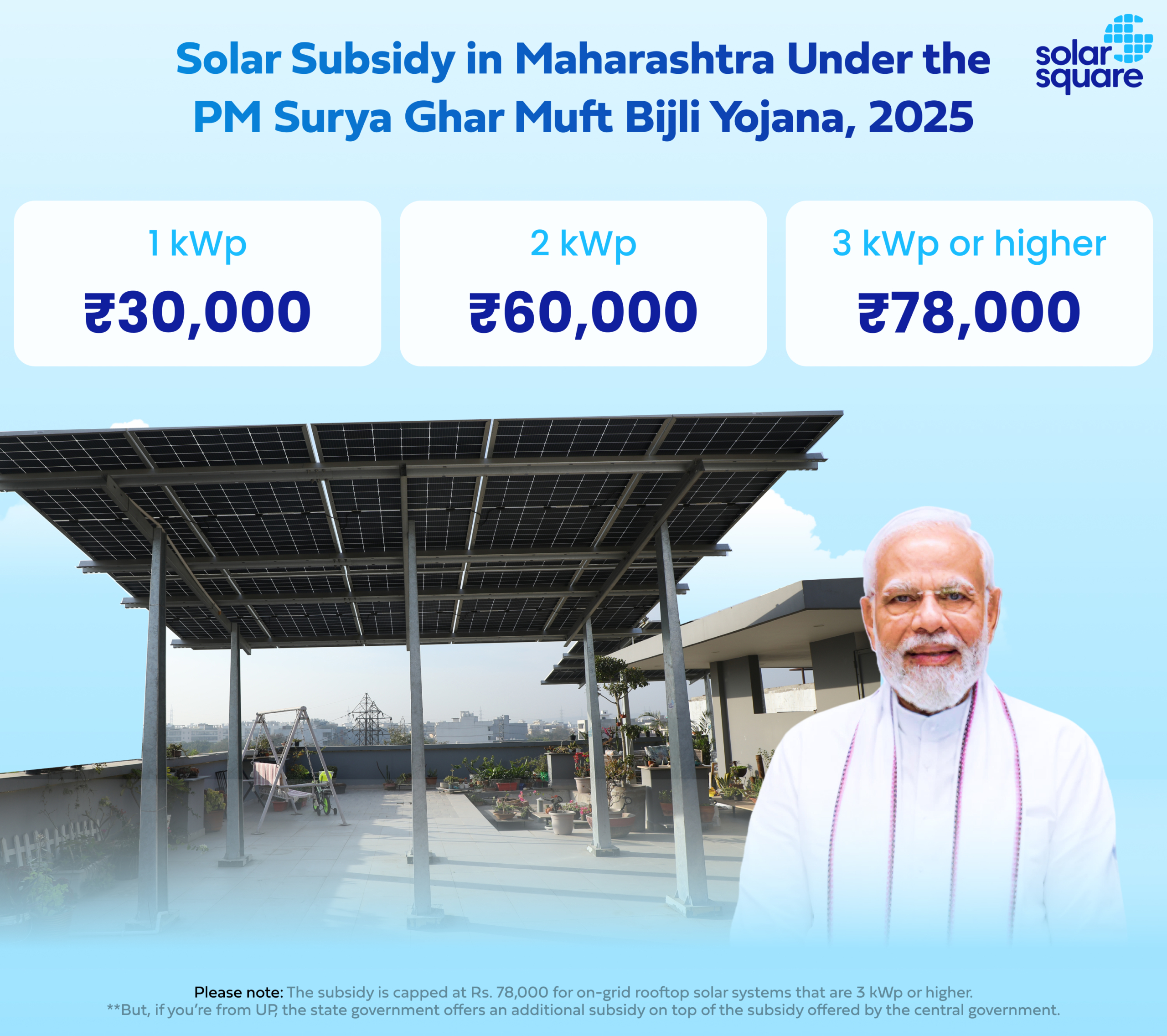
Per a January 2025 report on PIB (Press Information Bureau), Maharashtra is amongst the top 5 Indian states benefiting from the PM Surya Ghar Muft Bijli Yojana, with 1L+ homes already gone solar. For those of you who don’t know it yet, the PM Surya Ghar Muft Bijli Yojana is the government’s way of bringing solar prices within the reach of homeowners in India by offering a solar subsidy.
If you’re from Maharashtra and want to avail a solar subsidy in Maharashtra, this guide has all the answers you need: amount of subsidy you can get, whether or not you’re eligible for it, what’s the solar panel price in Maharashtra with and without a subsidy, and a lot more. Let’s get started with the most basic question – how much subsidy does the government offer?
What’s the Solar Subsidy in Maharashtra in 2025?
The central government offers a subsidy to Indian homeowners (including homeowners and housing societies). This subsidy remains the same for all Indian states, including Maharashtra.
The table below will walk you through the government subsidy for a solar power plant in Maharashtra under the PM Surya Ghar Muft Bijli Yojana:
| Solar System Size | Solar Subsidy Offered Under PM Surya Ghar Muft Bijli Yojana |
| 1 kWp | Rs. 30,000 |
| 2 kWp | Rs. 60,000 |
| 3 kWp and higher | Rs. 78,000 |
Please note: The subsidy is capped at Rs. 78,000 for on-grid rooftop solar systems that are 3 kWp or higher.
Are You Eligible for a Rooftop Solar Subsidy in Maharashtra?
If you meet the following requirements, you’re totally eligible to receive a solar panel subsidy in Maharashtra.
- You own a home with a suitable shadow-free rooftop
- Your solar panels are Made-in-India DCR Modules
- You have a valid electricity connection in your name
- You are an Indian citizen
- You have never availed of a solar subsidy for up to 3 kWp systems before on the same connection
Now that you know the details about how much subsidy you can get in Maharashtra, let’s examine the cost of installing solar panels in your home with and without a subsidy.
What’s the Solar System Cost in Maharashtra With and Without Subsidy?
The cost of installing solar varies from city to city. In this section, we will break down the solar system price list in Nagpur, Pune, Nashik, and Aurangabad for different solar system capacities with and without a subsidy.
Solar Panel Price in Nagpur With and Without Subsidy
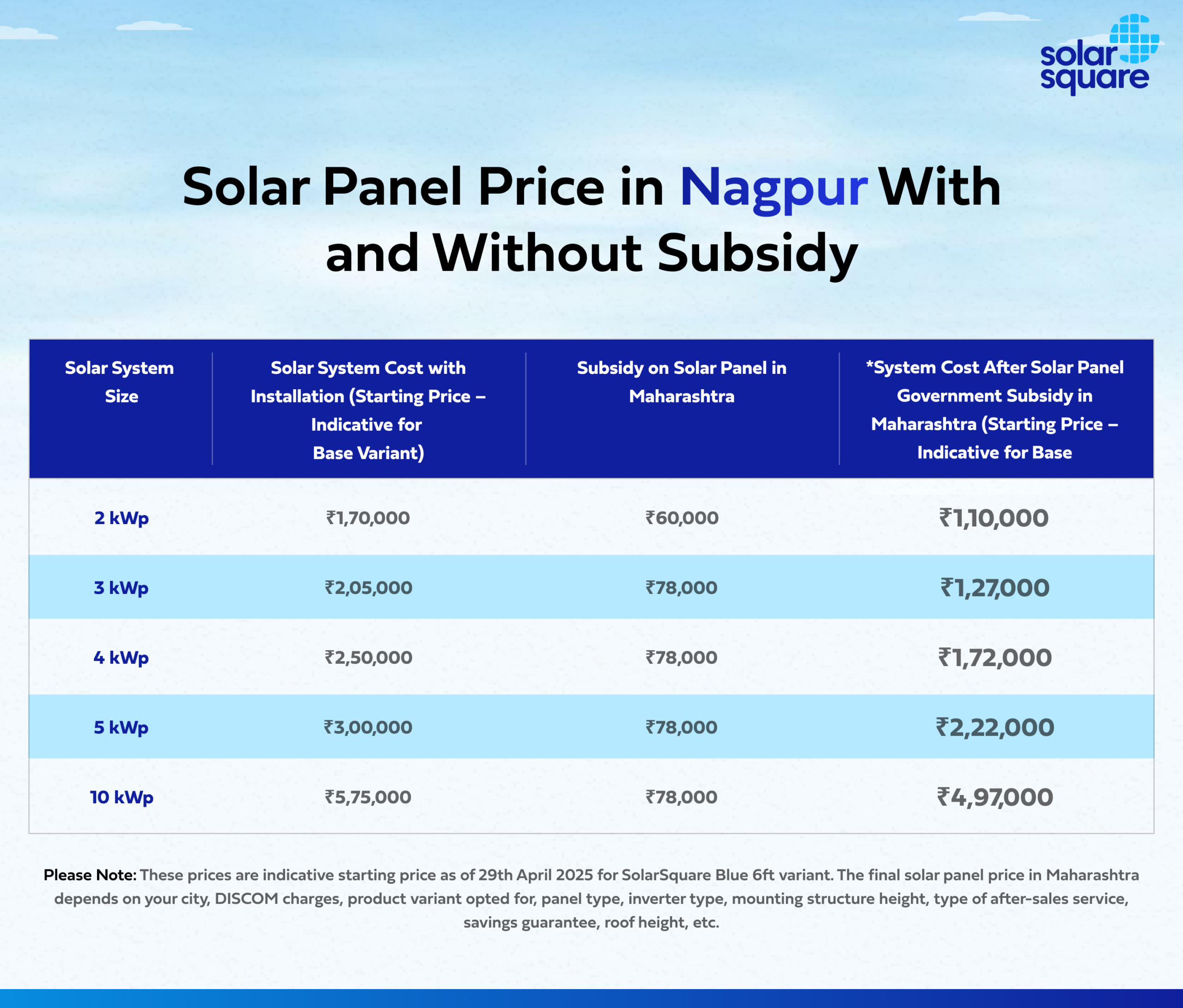
Here are quick sneak-peek into the solar panel price in Nagpur with and without a subsidy in 2025:
| Solar System Size | *Solar System Cost with Installation (Starting Price – Indicative for Base Variant) | Subsidy on Solar Panel in Maharashtra | *System Cost After Solar Panel Government Subsidy in Maharashtra (Starting Price – Indicative for Base Variant) |
| 2 kWp | ∼ Rs. 1,70,000 | Rs. 60,000 | ∼ Rs. 1,10,000 |
| 3 kWp | ∼ Rs. 2,05,000 | Rs. 78,000 | ∼ Rs. 1,27,000 |
| 4 kWp | ∼ Rs. 2,50,000 | Rs. 78,000 | ∼ Rs. 1,72,000 |
| 5 kWp | ∼ Rs. 3,00,000 | Rs. 78,000 | ∼ Rs. 2,22,000 |
| 10 kWp | ∼ Rs. 5,75,000 | Rs. 78,000 | ∼ Rs. 4,97,000 |
*Please Note: These prices are indicative starting price as of 29th April 2025 for SolarSquare Blue 6ft variant. The final solar panel price in Maharashtra depends on your city, DISCOM charges, product variant opted for, panel type, inverter type, mounting structure height, type of after-sales service, savings guarantee, roof height, etc.
Solar Panel Price in Pune With and Without Subsidy
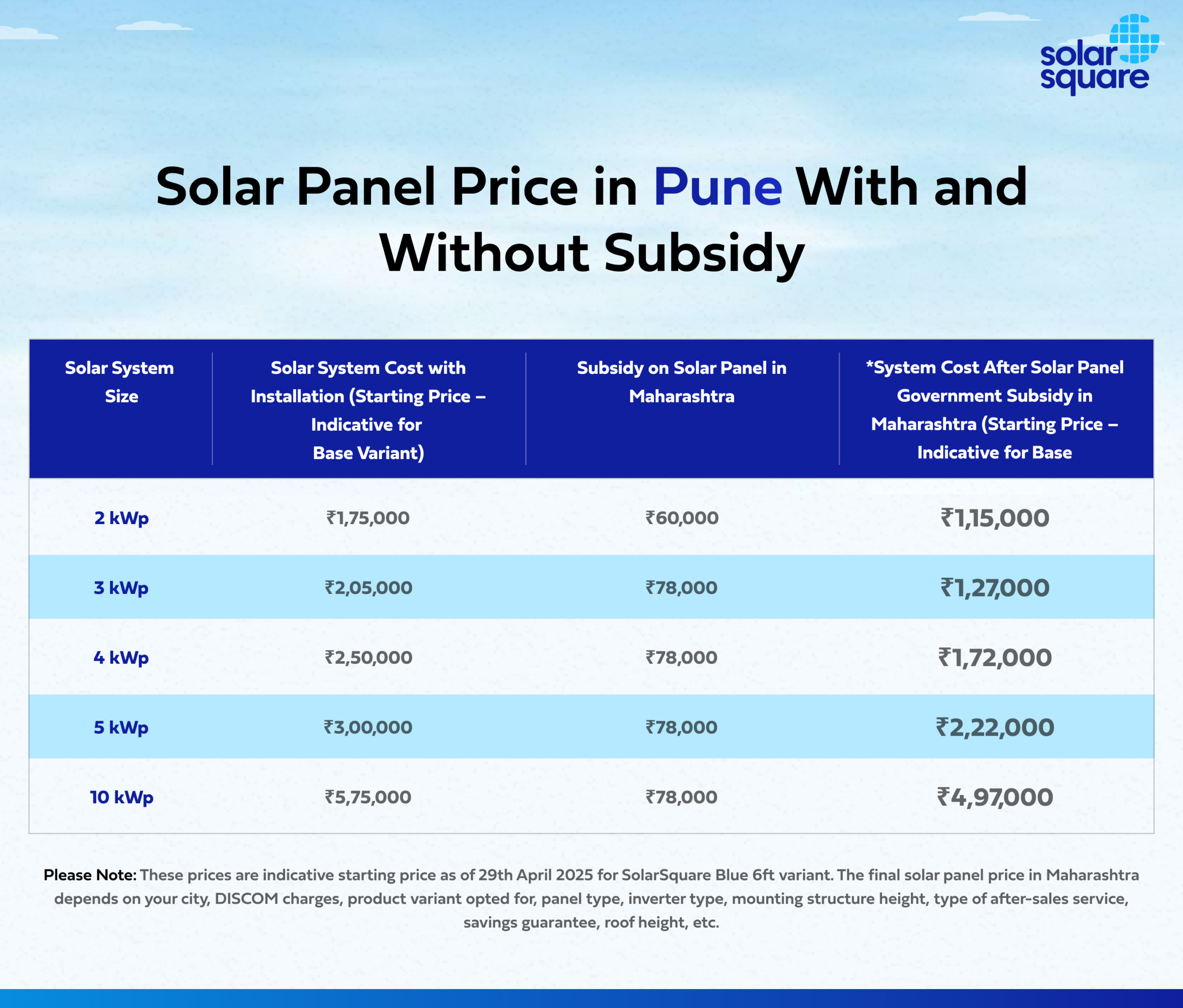
Here are the details about the solar panel price in Pune with and without a subsidy in 2025:
| Solar System Size | *Solar System Cost with Installation (Starting Price – Indicative for Base Variant) | Subsidy on Solar Panel in Maharashtra | *System Cost After Solar Panel Government Subsidy in Maharashtra (Starting Price – Indicative for Base Variant) |
| 2 kWp | ∼ Rs. 1,75,000 | Rs. 60,000 | ∼ Rs. 1,15,000 |
| 3 kWp | ∼ Rs. 2,05,000 | Rs. 78,000 | ∼ Rs. 1,27,000 |
| 4 kWp | ∼ Rs. 2,50,000 | Rs. 78,000 | ∼ Rs. 1,72,000 |
| 5 kWp | ∼ Rs. 3,00,000 | Rs. 78,000 | ∼ Rs. 2,22,000 |
| 10 kWp | ∼ Rs. 5,75,000 | Rs. 78,000 | ∼ Rs. 4,97,000 |
*Please Note: These prices are indicative starting price as of 29th April 2025 for SolarSquare Blue 6ft variant. The final solar panel price in Maharashtra depends on your city, DISCOM charges, product variant opted for, panel type, inverter type, mounting structure height, type of after-sales service, savings guarantee, roof height, etc.
Solar Panel Price in Nashik With and Without Subsidy
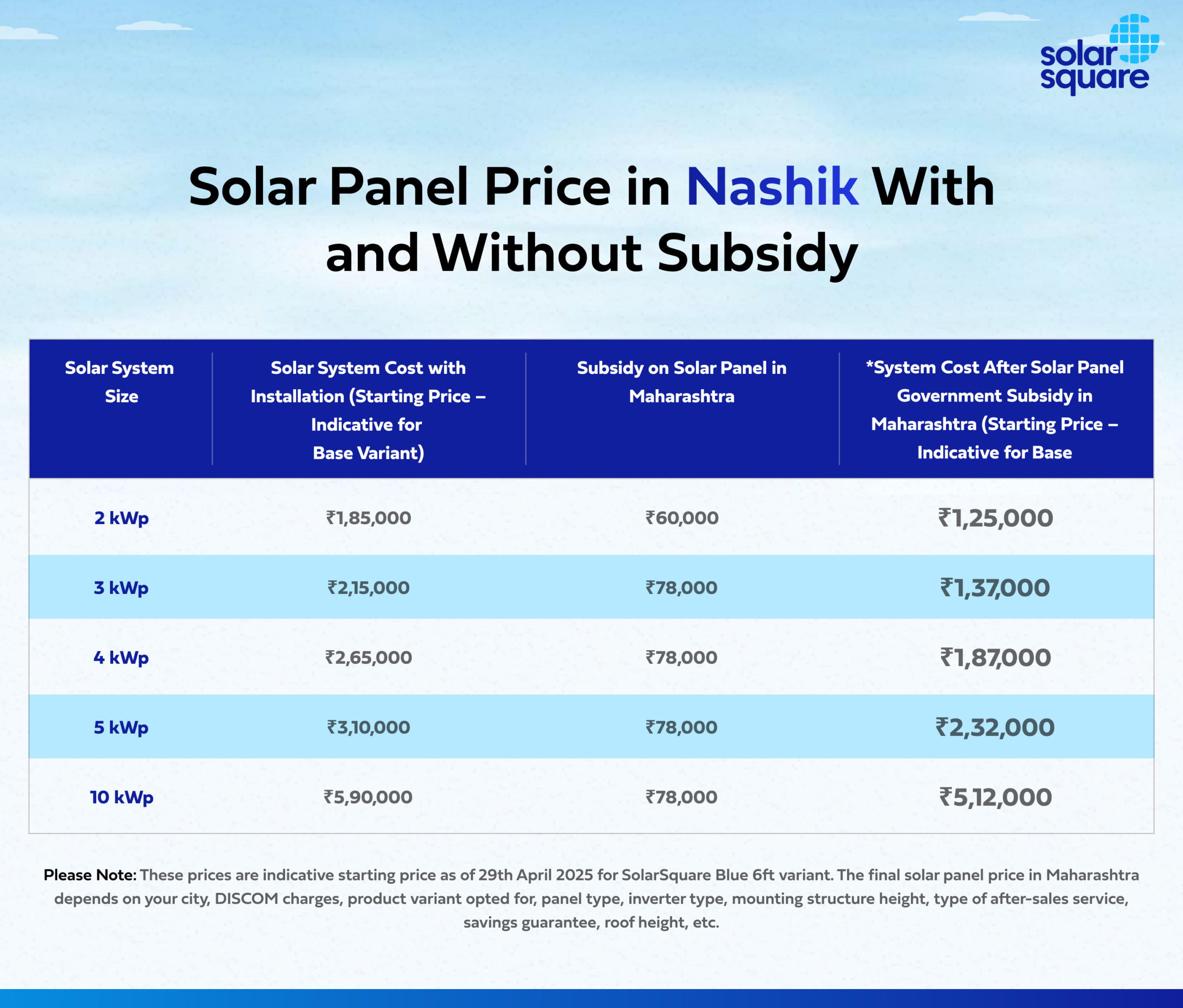
Here’s a detailed breakdown of how much a solar system costs in Nashik with and without a subsidy in 2025:
| Solar System Size | *Solar System Cost with Installation (Starting Price – Indicative for Base Variant) | Home Solar System Subsidy in Maharashtra | *System Cost After Solar Panel Government Subsidy in Maharashtra (Starting Price – Indicative for Base Variant) |
| 2 kWp | ∼ Rs. 1,85,000 | Rs. 60,000 | ∼ Rs. 1,25,000 |
| 3 kWp | ∼ Rs. 2,15,000 | Rs. 78,000 | ∼ Rs. 1,37,000 |
| 4 kWp | ∼ Rs. 2,65,000 | Rs. 78,000 | ∼ Rs. 1,87,000 |
| 5 kWp | ∼ Rs. 3,10,000 | Rs. 78,000 | ∼ Rs. 2,32,000 |
| 10 kWp | ∼ Rs. 5,90,000 | Rs. 78,000 | ∼ Rs. 5,12,000 |
*Please Note: These prices are indicative starting price as of 29th April 2025 for SolarSquare Blue 6ft variant. The final solar panel price in Maharashtra depends on your city, DISCOM charges, product variant opted for, panel type, inverter type, mounting structure height, type of after-sales service, savings guarantee, roof height, etc.
Solar Panel Price in Aurangabad With and Without Subsidy
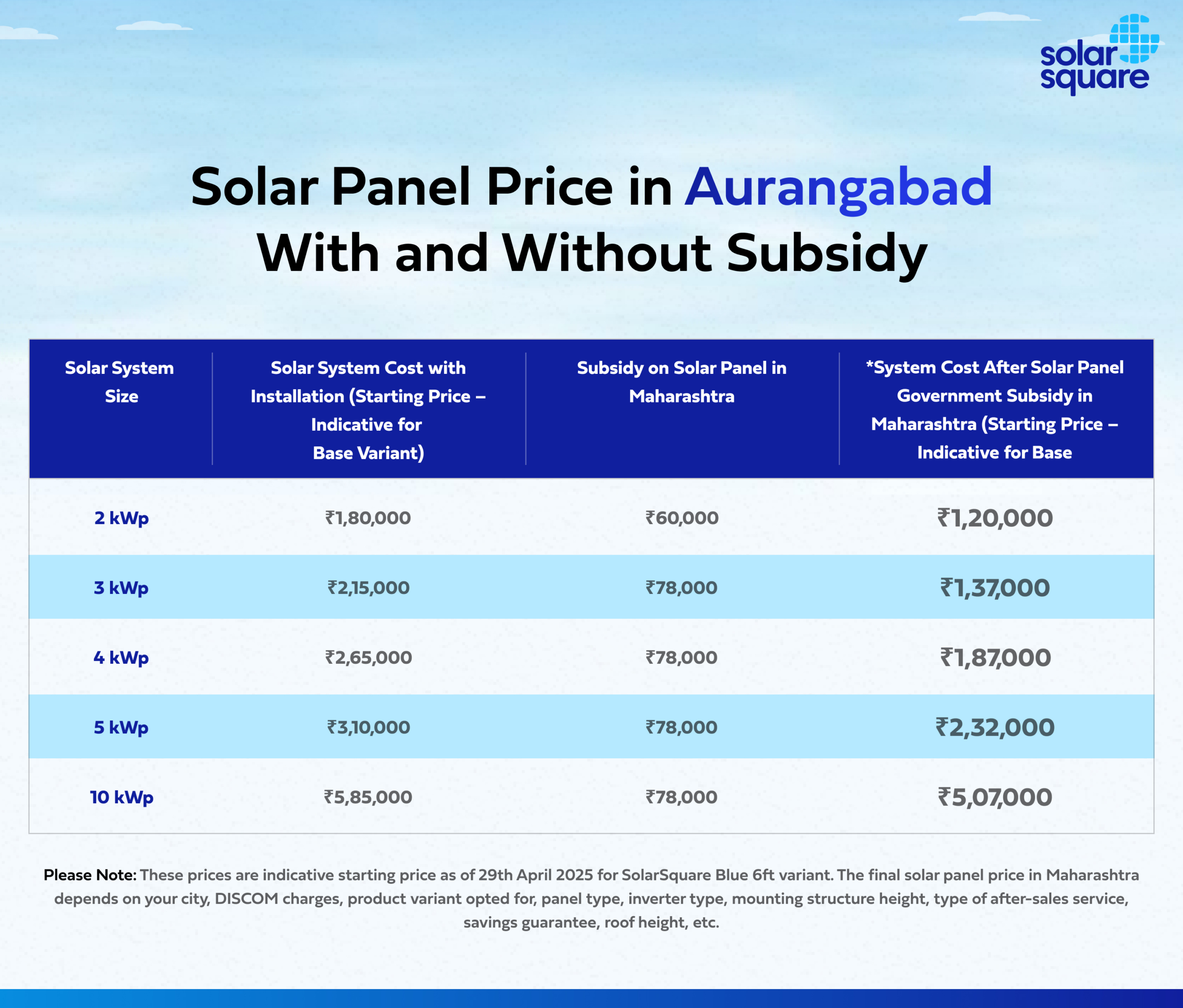
Here’s a snapshot of the solar system’s cost in Aurangabad with and without a subsidy in 2025:
| Solar System Size | *Solar System Cost with Installation (Starting Price – Indicative for Base Variant) | Subsidy on Solar in Maharashtra | *System Cost After Solar Panel Government Subsidy in Maharashtra (Starting Price – Indicative for Base Variant) |
| 2 kWp | ∼ Rs. 1,80,000 | Rs. 60,000 | ∼ Rs. 1,20,000 |
| 3 kWp | ∼ Rs. 2,15,000 | Rs. 78,000 | ∼ Rs. 1,37,000 |
| 4 kWp | ∼ Rs. 2,65,000 | Rs. 78,000 | ∼ Rs. 1,87,000 |
| 5 kWp | ∼ Rs. 3,10,000 | Rs. 78,000 | ∼ Rs. 2,32,000 |
| 10 kWp | ∼ Rs. 5,85,000 | Rs. 78,000 | ∼ Rs. 5,07,000 |
*Please Note: These prices are indicative starting price as of 29th April 2025 for SolarSquare Blue 6ft variant. The final solar panel price in Maharashtra depends on your city, DISCOM charges, product variant opted for, panel type, inverter type, mounting structure height, type of after-sales service, savings guarantee, roof height, etc.
How to Apply for a Solar Rooftop Subsidy in Maharashtra?
Applying for a solar subsidy in Maharashtra has never been simpler. Before we take you through the process of applying for a solar rooftop subsidy in Maharashtra, you must also know the documents you’ll need to get the subsidy.
Documents Required to Avail a Solar Rooftop Subsidy in Maharashtra
You’ll need to upload the following documents to avail the subsidy:
- Proof of Identity (Aadhaar or PAN)
- Latest electricity bill
- Proof of Ownership like property papers (in case of a correction in electricity bill)
Step-by-Step Guidance on Applying for a Home Solar System Subsidy in Maharashtra
Here’s a detailed outline of all steps you must follow to install solar and apply for a subsidy:
- Portal Access: Visit the PM Surya Ghar Muft Bijli Yojana Portal.
- Register Your Account: Enter your mobile number and verify it using the One-time Password (OTP). Once verified, provide your name, select your state and district, and complete the remaining profile fields. Next, enter your email address, verify it with the OTP, and click Save to finalize your profile.
- Choose Solar Vendor: When prompted, choose Yes if you’d like your vendor to complete the application on your behalf. Select No if you prefer to apply yourself.
- Enter Bank Details to Kickstart Subsidy Reimbursement: After receiving feasibility approval, pick your vendor and submit your bank account details to initiate the subsidy disbursement process.
- Proceed with Installation Verification: Once the solar plant installation is finished, your vendor will send the installation details to you for confirmation. After you verify, the vendor forwards these details to the DISCOM.
- Final Inspection and Subsidy Disbursement: The DISCOM conducts a site inspection and shares the inspection report with you. Finally, you redeem your subsidy and submit the claim to the National Program Implementation Agency (NPIA).
Check out this video for further details to avail a subsidy.

How’s the Government Simplifying Solar Subsidy and Net Metering in 2025?
Before 2024, the process to apply for a solar subsidy and net meter installation weren’t that straightforward. But as of 2025, both the processes have been super simplified.
Here’s a simple comparison to give you an idea of how things have changed for good:
| Aspect | Before 2024 | In 2025 |
| Application Approval | Once the application was submitted, DISCOM officials performed a technical feasibility inspection. | Residential solar projects up to 10 kW are now exempt from the technical feasibility inspection requirement for application approval. |
| Installation commencement | Installation work started only after the relevant DISCOM official had granted approval. | It starts the minute the application is registered on the National Portal for Rooftop Solar. |
| Required documentation | All states mandated the following documents for technical feasibility approval and net‑meter commissioning – a). Aadhar card b). A copy of the electricity billc). Property/housing tax receiptd). Passport size photo | For technical feasibility inspection — latest electricity bill. For project commissioning – A copy of the project completion report, a photograph of the solar system installed, and the consumer-vendor agreement |
| Bi-directional meter installation timeline | Roughly 60 days after submitting the net metering application. | Within 30 working days after submitting the net metering application. |
What Are the Benefits of Availing a Solar Subsidy in Maharashtra?
The biggest standout benefit of applying for a solar subsidy in Maharashtra is getting solar installed at much cheaper rates. Moreover, you must keep in mind that the solar subsidy for residential installations will not be offered forever. The government will stop offering a subsidy once it hits its target of solarizing enough households in India.
Here are some of the most compelling reasons that going solar in 2025 matters more than ever:
- Help Fight Climate Change: Installing a 1 kW solar system is equivalent to planting 39 full-grown trees. That’s how great it is for the environment.
- Produce Your Own Electricity: Your reliance on the grid for power will drop dramatically as your rooftop solar system will be your primary source of energy.
Then, there’s the matter of immense solar savings – let’s dive into the details!
How Much Money Can Rooftop Solar Systems Save?
The lifespan of a solar system is 25 years. It keeps saving you money throughout its life by making electricity free for you. How? Well, you don’t have to pay for electricity any longer, and your initial investment on solar breaks even in 3-5 years.
Let’s give you an estimate of how much money you can save by installing a 5 kW solar system in Nagpur.
Here are a few considerations:
- The assumed electricity tariff is Rs. 15.2 per unit
- Electricity rates increase by 3-6% every year
- Solar systems degrade annually at 1%
Considering all the factors listed above, a well-maintained 5 kW solar system in Nagpur can save Rs. 34 lakh+ in its 25-year life.
Not from Nagpur and want to check how much money can going solar save you? Use SolarSquare’s Solar Power Savings Calculator.
Calculate your savings

Forecast your savings with solar on your investment on the SolarSquare’s plant
Conclusion
2025 is the best time to go solar because the Indian government offers a solar subsidy in Maharashtra. If you’re eligible for a subsidy, the final system cost will be reduced dramatically. For instance, the starting solar panel price in Nagpur with installation for a 3 kW solar system is ∼ Rs. 2,05,000. A solar subsidy in Maharashtra for a 3 kW system is Rs. 78,000. So, when you avail this subsidy, the price drops from ∼ Rs. 2,05,000 to ∼ Rs. 1,27,000.
Moreover, installing an on-grid rooftop solar system will also give you freedom from paying for electricity ever again. You save tens of lakhs of rupees over the system’s lifespan of 25 years. So, why wait any longer? Book a free solar consultation with SolarSquare today. Let us handle the nitty-gritty of going solar while you settle back to enjoy free electricity for the next 25 years of your life.
Solar Subsidy In Maharashtra FAQs
Q. Is there any subsidy on solar panels in Maharashtra?
A. Yes. The central government offers a subsidy to homeowners installing on-grid rooftop solar systems. Here are the latest subsidy details:
- 1 kWp system: Rs. 30,000
- 2 kWp system: Rs. 60,000
- System with 3 kWp or Higher Capacity: Rs. 78,000
Q. How many days will it take to get a solar subsidy?
A. It takes approximately 30 working days to receive the subsidy after the solar system is installed and commissioned.
Q. How to read a solar electricity bill?
A. Here are some simple steps to follow:
- Locate Your Meter: Find your solar net‑meter near the main panel or outside.
- Read IMP (Import): Shows total kWh drawn from the grid.
- Read EXP (Export): Shows total kWh sent back to the grid.
- Check NET: The difference between import and export (positive = you owe, negative = you have credit).
Q. Do I need to change my meter for solar panels?
A. Yes. Once the solar system is installed on your rooftop, your DISCOM will install a net meter (also known as a bidirectional meter). This net meter keeps a record of the units imported and exported to and from the grid. A bill is created based on the readings recorded by the bidirectional meter.
Reference Links:
